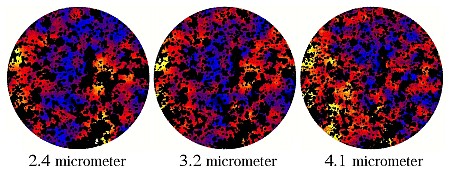AKARI Results
AKARI detected the light from the first stars
Japanese infrared astronomy satellite AKARI measured the sky brightness at the wavelength of 1∼4 micrometers and detected large spatial fluctuation that cannot be explained by the known sources. This fluctuation can be attributed to the clustering of the first stars of the universe, which were formed 300 million years after the Big Bang. The result will provide an important clue for the investigation of star formation history in the early universe for which little observational evidence has been found. The paper will be published in the November 1st issue of The Astrophysical Journal.
It is well known that universe was created by the Big Bang and evolved to be the present universe through expansion. The universe at 400 thousands years after the Big Bang is known to be fairly uniform and isotropic from direct observations of the cosmic microwave background radiation. On the other hand, the present universe is extremely non-isotropic; there exist stars, galaxies, and vacant space. The large aperture ground-based telescopes have detected galaxies at several hundred million years. However, very little observational evidence is known for the period between them, and the period is known as "dark age of the universe". Theoretical works predict that the first stars of the universe were formed in that period and non-isotropic universe was initiated. However, these stars are too faint to be detected individually. The group headed by Toshio Matsumoto, Professor Emeritus of ISAS/JAXA and Visiting Professor of Seoul National University, has tried to observe light of the first stars as background radiation.
The group observed the fluctuation of the sky brightness towards the Draco region for half a year with Japanese infrared astronomy satellite AKARI. They obtained sky images at 2.4, 3.2 and 4.1 micrometers (Figure 2), and found significant fluctuation in the background images after removing foreground discrete sources (Figure 1). The observed fluctuation is fairly large and cannot be explained by known foreground diffuse sources, such as zodiacal light caused by dust in the solar system, lights of faint stars in out Galaxy and distant galaxies, etc. Fluctuation pattern is almost identical for the three wavelength bands, and its spectrum is consistent with that of distant blue stars. The evidence indicates that observed fluctuation is attributed to the clustering of the first stars of the universe.

Figure 1: The data analysis procedures are shown for the case of 2.4 micrometers. 1. One exposure (44 sec) image taken by AKARI. Field of view is 10 arcmin (1 arcmin is 1/60 degree). Objects in the image are mostly distant galaxies. 2. To improve the data quality, 40 images obtained during half a year observing period are stacked into an image. Since the field of view rotates during the period, the stacked image is circular shape of 10 arcmin diameter. 3. The objects identified as foreground objects are masked on the image. Fluctuation of the sky brightness can be seen. Fluctuation of small angular scales is caused by randomly distributed unidentified faint galaxies. 4. The image is smoothed for 50 arcsec. Small-scale fluctuation is suppressed and large-scale fluctuation is clearly observable.

Figure 2: The fluctuation maps obtained by AKARI towards the North Ecliptic Pole. The image at 2.4, 3.2 and 4.1 micrometers are shown from left to right. The colors blue-red-yellow designate the sky brightness from dark to bright. Diameter of the images is 10 arcmin, which corresponds to one million light year in the present universe assuming that the origin of fluctuation is the first stars of the universe.
The angular scale they observed is larger than 100 arcsec (1 arcsec is 1/3600 degree), which corresponds to the large-scale structure in the current universe. This angular scale is consistent with the theoretical prediction that first stars were formed at the high-density region of the dark matter. This indicates that the large-scale structure was already formed in the era of first stars (supposed to be about 300 million years after the Big Bang).
It is a first time that the clear visual images showing large-scale structure are obtained. Previous observations could not obtain clear results because the field of view was too narrow (HST), or the wavelength range was restricted to the longer wavelengths (Spitzer).
The research group of Matsumoto et al. detected excess background radiation that could be attributed to the light of the first stars using the data taken by the Japanese space infrared telescope, IRTS, onboard the Space Flyer Unit (SFU) operated in 1995. The present research confirmed the existence of the first stars through the observation of fluctuation of sky brightness.
The evidence of this research is extremely important to investigate the dark age of the universe, and will delineate the formation and evolution of the first stars and the large-scale structure.
This research was performed under the collaboration of following persons. T. Matsumoto (Professor Emeritus), H. Matsuhara (Professor), S. Matsuura, T. Wada (Assistant Professor) and S. Oyabu (Research Fellow (present position is Assistant Professor of Nagoya University) from ISAS/JAXA, T. Matsumoto (Visiting Professor), H. M. Lee (Professor), H. J. Seo (Graduate student) from Seoul National University, and W. -S. Jeong (Senior Researcher), J. G. Pyo (Research Fellow) from Korean Astronomy and Space Science Institute
Materials
- Figure 1 (© JAXA & Seoul National University)
- Figure 2 (© JAXA & Seoul National University)





